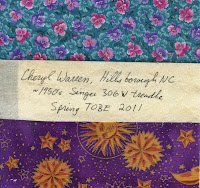The Treadle On folks hold several block exchanges a year. TOBE = Treadle On Block Exchange. The blocks must be pieced on a people powered machine such as treadle or a hand crank. The spring exchange this year was a simple rail fence and I decided to join in.
Somehow I always manage to fall into projects that take on a life of their own. I had never been in a block exchange before, and originally I was just going to make a minimum number to see how it worked. Honestly.
A year ago when SMAD (Sewing Machine Acquisition Disorder) first struck, I didn't take the DH's grandma's Singer 66 out of the treadle to clean it because I was afraid I wouldn't be able to put it back together properly. Those two tiny screws are no big deal to me now. After making the first set of TOBE blocks I began swapping machines in and out of the treadle like mad. I tried the hand crank on everything in sight. I learned a lot along the way and finally bonded with the little Singer 99.
Singer 128 hand crank conversion. Too small to fit in the treadle.
Singer 99K hand crank conversion, also too small to fit in the treadle. I hated this machine when it had a motor (I think the motor needs some serious work), but as a hand crank it is lovely. I have since performed a motorectomy and bought it its very own spoked wheel and hand crank. Next I will try it with leather. Leather workers love this model with the hand crank.
Singer 127, The Sphinx. Lovely as a hand crank or treadle. Just lovely in general. Sigh....
Singer 309K two-toned, acquired while I was working on the TOBE blocks. I also have another, MUCH uglier 306W. Both of these worked fine in the treadle with the spoked wheel from the Singer 66 (or any other spoked wheel AFAIK). This was great news because I have plans to paint the ugly 306 and put it in a treadle. Neither one of these worked with the hand crank, however. There just was not enough clearance for the wheel to turn. I have seen 306 hand crank conversions, but to do it you have to drill a hole in the solid hand wheel.
I ended up sending the maximum number of blocks for the exchange: 60. I received the blocks from the other participants and they are lovely. Because everyone has their name and town on them, I don't think I should share them here, but I will share some of the ones that I made. Enjoy!
This was the first block exchange I have ever done and it was fun. The purpose of Treadle On is to encourage the use of (rather than merely the collecting of) people powered machines. It's a very friendly group and there are some novice quilters there who got into sewing through owning the machines, rather than the other way around. The most intimidating part of the whole thing was all that PENMANSHIP. Never my strong suit when I was young, it is a nightmare with a hand with a couple of old-lady-type-frozen-up-finger-joints. But I surprised myself and surpassed my very minimal expectations. I think they were all legible.
I also learned why you can't treadle or hand crank a Singer 15-91. Of course it is obvious once you know, but seeing is worth way more than a written explanation. In short it's gear driven rather than belt driven. Taking off the hand wheel and peering into the gears was a revelation for me and now I "get" it and understand that machine much better. I took the opportunity to pick out the 50 years old lube and re-lubed it, too.
The Harmony and Light Quilt Along!
1 year ago




































